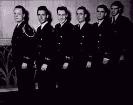| Curator's
note: The article below appeared in the September 13th, 1929 edition
of the New York Times. |
Plans for radio studios
called "the world's most pretentious" were announced yesterday by M.
H. Aylesworth, president of the National Broadcasting Company, to be situated
on the roof of the Merchandise Mart in the heart of Chicago. Formal opening of
the new quarters, tentatively planned for Jan. 1, 1930, will be a definitive step
in fulfillment of Mr. Aylesworth's prediction two years ago that Chicago is destined
to become one of the great broadcasting centres of the country. The fact that
the Chicago headquarters of the National Broadcasting Company are to be more pretentious
than those now in use in New York, Washington or San Francisco is regarded as
a significant recognition of Chicago's position in the broadcasting field.
More Concerts
from Mid-West
An increasing
number of programs are being originated in Chicago studios, and pressure of the
business has necessitated expansion virtually impossible in the present location
in the Lake Michigan Building. It is pointed out that in the new location special
construction will eliminate many of the physical and mechanical limitations of
the usual office building. There will be six studios, fully equipped with the
latest developments in radio apparatus. Wire lines and other facilities will be
installed permitting expansion to an unlimited number of studios. "Studio
A will be the largest radio theatre in the world", said Mr. Aylesworth. It
will be 75 feet long, 51 feet wide with a 26 foot ceiling, giving a total floor
space of 3,820 square feet and a total content of 99,450 cubic feet. It will provide
standing room for 1,000 persons, it is estimated. "The studio will have a
large number of innovations in equipment. Instead of the usual velvet on monks's
cloth drapes utilized in the regulating of acoustical effects, it will be walled
with adjustable narrow panels. These strips will be movable in such manner as
to present refractive, neutral or absorbing surfaces to the sounds produced in
the room." A great pipe organ and organ loft specially adapted for radio
representations of varied character will be installed. A raised stage for use
in productions permitting the presence of an immediate audience, and also useful
in balancing and placing of large orchestras will occupy one of the studios. The
other studios will vary in floor size and ceiling height to meet various acoustical
conditions and adaptations to various sized musical aggregations.
Floating Walls
Used
Each studio will have
its own monitoring and observation room adjacent and a soundproof glass partition
will separate them. The monitor rooms will be raised above the studio level in
order to give the studio engineer and production director better views of the
performance. Further, each studio will have a soundproof glass enclosed balcony
to enable guests to both see the performance in the studio and hear it through
loud-speakers as the radio audience hears it. Ann studio units will be thoroughly
soundproofed through the medium of floating walls and floors. The studios will
be without windows (and partially hermetically sealed for soundproof), the vestibule
being regulated through modern equipment maintaining a constant flow of pure air
at a regular temperature and with a uniform degree of humidity. With this system
temperature is automatically maintained within a variation of two degrees Fahrenheit.
In the centre of the main control rom will be two main control room boards, each
30 feet long. One will be used for amplifiers and control of studio equipment.
The other will carry the apparatus which controls connections with wires carrying
programs to and from points outside the studios and will permit of expansion.
A master control desk in this room will be the nerve centre at which the routing
of all programs and can supervise the cutting of programs on and off the networks
from studio to studio. Delicately adjusted time-system clocks will show the correct
time to the fraction of a second, an item of major importance in regulation of
programs over far-flung networks. All equipment, including power supply, will
be installed in duplicate to insure uninterrupted transmission of programs.
|

